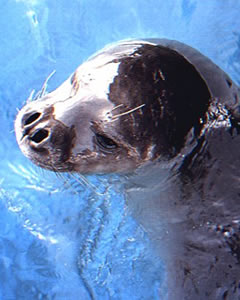|
Mediterranean
monk seal
(Monachus monachus )

Copyright
photographer Carlo Ravenna, under permission
Geographical
distribution
Aristotle
described the Mediterranean monk seal in the third century
B.C. Once aboundant in some areas of the Pacific, Caribbean,
and Mediterranean seas, there are only a few remaining today.
They live in a few places in the Mediterranean and Hawaii.
Their world population is approximately 500 and in the Mediterranean
they are less than 350.
Characteristics
Monk seal
is pinniped, a word which means “fin foot”. It
has been called a “living fossil”, because fossils
show it was hunting as long as 15 million years ago. The monk
seal is the only seal who lives in hot seas. It reach about
2m in lenght and 180kg in weight and is a very speedy swimmer.
|
|
Behaviour
and reproduction
Monk seals
feed at night in coastal waters and sleep on beaches during
the day, often digging in the ground to lie in cooler sand.
They eat lobsters, eels, octopus, and some reef fishes.
Monk seals reproduce slowly, starting at age of four.
Adult females, larger than the males, come ashore to give birth to one pup,
then they remain on the beach nursing and protecting the pup for 6 weeks. During
this period the female does not leave the pup to feed herself, but it lives
of stored fat. The pup may stay with its mother for three years.
Influence of man
The Mediterranean
monk seal has been classified as endangered since 1966. Mortality
is above all caused by the fishing. This seal was hunted for
food by early explorers and native. It is now protected, but
it is yet threatened by habitat destruction, tourism, human
population growth, boat traffic, overfishing of its prey and
pollution.
Conservation
actions
An agreement
has been signed by France, Italy and the Principality of Monaco
for the creation of an international sanctuary for Mediterranean
cetaceans to protect them. |

